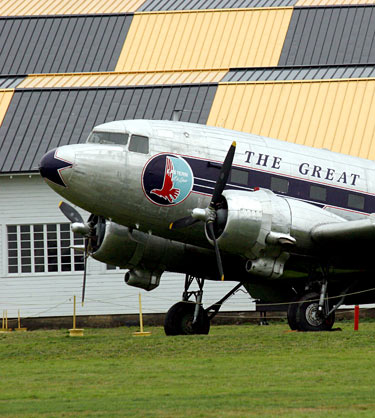Pearson Field, located in Fort Vancouver National Historic Site, is a historically significant center of aviation in the Pacific Northwest. In 1905, the first aeronautical event took place here when Lincoln Beachey, one of the most talented early aviators, landed a dirigible on the parade grounds of the U.S. Army's Vancouver Barracks. The first airplane flight in the Vancouver-Portland, Oregon, region took place in 1910, and generated much public interest.
Air reserve training
In 1923, the Army established an airfield at the Vancouver Barracks and assigned the 321st Observation Squadron to the field, led by Lt. Oakley Kelly, to expand air reserve training. The squadron used four Curtiss JN-4 Jennies and one Dehavilland DH-4 aircraft to teach the Army Reserve Officers how to fly.
First transcontinental flight
Lt. Kelly was a major figure in the U.S. Army Air Service, and attracted national attention when he and Lt. John A. Macready completed the first transcontinental flight in April 1924. Pearson Field was the last stopover in the Army's epochal Round-the-World flight in 1924, which demonstrated the range of military aircraft and allowed advocates of air power to promote Army aviation. Pearson had also been commissioned by the Department of the Interior to make the first aerial survey of Grand Canyon National Park.
In 1925, Kelly pushed to rename the airfield in honor of Lt. Alexander Pearson, a Vancouver native and exemplary Army aviator who was killed in an aviation accident in 1924.
Commercial airlines
During Kelly's assignment to the airfield (1924-1928), he actively promoted the expansion of civilian involvement in aviation in Vancouver and was instrumental in the establishment of the adjacent commercial field. The Vancouver Chamber of Commerce worked with Kelly to establish this field in 1925. This expansion allowed a home for general aviation and for early commercial airlines, and enabled Pearson to bid for an airmail route. The original West Coast airmail service stopped at Pearson. Both Pacific Air Transport and Varney Airlines used the field, and later joined with two other airlines to become United Airlines.
First transpolar flight
In 1937, Pearson Field was the landing site of the courageous crossing of the North Pole by three Soviet aviators in the ANT-25, a single-engine aircraft designed by the Soviet Union for long-range flight. This important milestone in aviation--the first transpolar flight--prompted intense public interest and attracted national attention. A monument was erected to commemorate the flight.
In 1941, the 321st Squadron was called to active duty, and Pearson ceased to be an active Army Air Corps base. The original grass field, surviving military structures and the backdrop of the Officers Row reflect the interwar period during which Pearson was an active aviation center. In the late 1940s, the city of Vancouver assumed responsibility for Pearson after it was declared surplus by the military, and since that time, the field has been an area for general aviation. The Army airfield and adjacent commercial airfield were joined and became known as Pearson Airpark which continues to serve the greater Vancouver-Portland area.
- Listed on the Washington Heritage Register in 1990.
Open to Public:
This property is open to the public as the Ridgefield National Wildlife Refuge.

Pearson Field
E Reserve St & E 5th St.
Vancouver, WA 98661
United States